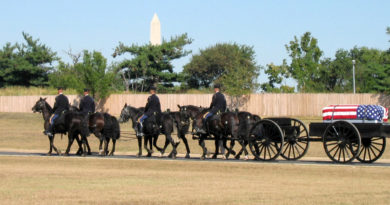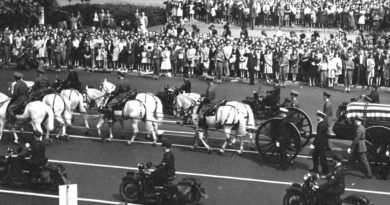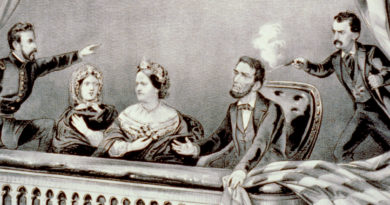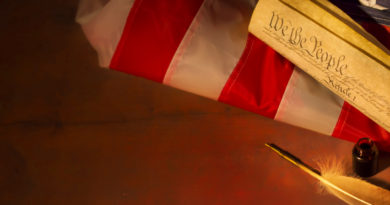Black Jack: The Riderless Horse in JFK’s Funeral
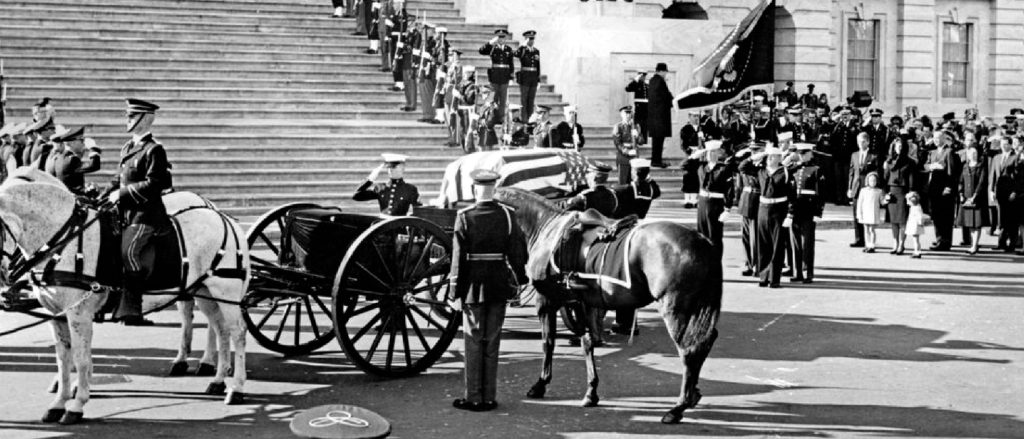
Following the assassination of President John F. Kennedy on November 22, 1963, millions of people worldwide watched the aftermath of the tragedy unfold live on their television sets for the next several days. This included not only the return of Kennedy’s body to Washington, D.C., aboard Air Force One later that day, but also Jack Ruby shooting Lee Harvey Oswald on November 24, and the president’s funeral at Arlington National Cemetery the next day.
Decades later, people still vividly recall the startling events and indelible images from that fateful November weekend, including the striking black caparisoned horse carrying empty riding boots that followed the president’s casketed remains along the streets of the nation’s capital. This article offers the interesting life story of Black Jack, the iconic riderless horse in President John F. Kennedy’s funeral procession, and the rare honor this horse received after death.
Black Jack: Destined to Remain Riderless
Born (or “foaled”) on January 19, 1947, the black quarter horse with the small white star on his forehead was named “Black Jack” in honor of U.S. Army General John J. Pershing, who led America’s military forces to victory in Europe during World War I. The horse received the U.S. Army brand on his left shoulder, and an Army serial number (2V56), before his training began at Oklahoma’s Fort Reno.
Displaying a feisty, spirited attitude from the start, Black Jack did not like to carry riders, which proved problematic since supplying well-trained horses was one of the functions of the Army’s Quartermaster Corps. Rather than sell the strong-willed but handsome beast, the Army decided to transfer the horse to Virginia’s Fort Myer.
In an eerie coincidence, six-year old Black Jack joined Fort Myer’s 3rd U.S. Infantry Regiment (known as “The Old Guard”) on November 22, 1953 – exactly 10 years before the assassination of President John F. Kennedy.
There, still unwilling to carry riders, Black Jack was placed into The Old Guard’s Caisson Platoon, which provided services for military funerals, such as pulling funeral caissons and providing caparisoned or “riderless” horses.
JFK’s Funeral Procession
Following President Kennedy’s assassination, his wife Jacqueline drew from the funeral services for America’s first slain president, Abraham Lincoln, when planning her husband’s services. Among various presidential funeral traditions, she too wanted a caparisoned horse to follow the caisson during the funeral procession from the White House to the U.S. Capitol. A caparisoned or riderless horse symbolically represents a “fallen warrior” or a leader who will lead no more.
For this honor, 16-year-old Black Jack was selected to carry a pair of polished, spurred boots placed backward in the saddle’s stirrups, and a sword or saber, during JFK’s funeral procession. Pfc. Arthur Carlson, a 19-year-old member of The Old Guard, would lead the horse.
On that solemn day (November 24), the journey from the White House to the U.S. Capitol did not go smoothly, however. Before departing, Black Jack “constantly danced around and threw his head.” En route, a metal grate leaning against a tunnel wall fell over, making a “hellacious noise,” which added to Black Jack’s agitation.
The following day, during the funeral service at Saint Matthew’s Cathedral, Black Jack pawed the ground outside with his hoof and accidentally stepped on Pfc. Carlson’s foot. Worried he’d suffered a broken bone or two, Carlson fortunately escaped physical injury but later had to replace his damaged shoe. Not surprisingly, The New York Times would describe Black Jack the riderless horse as “spirited and difficult to handle.”
Retirement, Death and High Honor
Despite the challenges he created during JFK’s funeral procession, Black Jack would again serve as the caparisoned horse in the funeral for two more U.S. presidents: Herbert Hoover in 1964, and Lyndon B. Johnson in 1973. He also performed his riderless role during the funeral of General Douglas MacArthur in 1964, as well as more than 1,000 other military funerals.
Eventually, however, Black Jack grew too old for active duty and retired to the 3rd U.S. Infantry Stables on June 1, 1973. Because of his prominent role in President Kennedy’s funeral procession, countless area school children visited this equine celebrity afterward, and President Richard Nixon actually sent a birthday card to Black Jack on the horse’s 29th birthday!
As it does with all living things, however, time and old age finally caught up to America’s riderless horse and, suffering from arthritis and other maladies, Black Jack was euthanized on February 6, 1976.
After his cremation, his remains were buried on the parade grounds of Fort Myer. Fittingly, Black Jack received full military honors during his funeral service – only the second horse to receive this distinction in U.S. history – and his remains were transported using the same caisson he’d walked behind during the funerals of three American presidents.
Sources:
“Remembering Black Jack” by Coree Reuter, November 23, 2013. The Chronicle of the Horse. Retrieved January 28, 2020. http://www.chronofhorse.com/article/remembering-black-jack
“Alabama man recalls leading riderless horse for JFK” by Jeremy Gray, November 21, 2013. Scottsbluff Star-Herald. Retrieved January 28, 2020. http://www.starherald.com/alabama-man-recalls-leading-riderless-horse-for-jfk/article_fb22491c-5321-11e3-a563-0019bb2963f4.html
“‘Black Jack’ Famous Kennedy Funeral Horse Dies” by Matt McFarland, February 7, 2006. www.wsfa.com. Retrieved January 28, 2020. http://www.wsfa.com/story/4473361/black-jack-famous-kennedy-funeral-horse-dies


